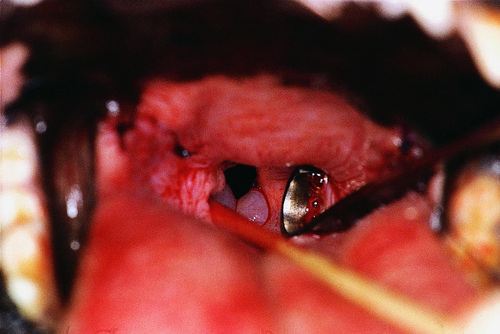Small Animal Soft Tissue Surgery Q&A 07
The larynx of a four-yearold, male Pug presented to the emergency clinic for dyspnea and cyanosis.
| Question | Answer | Article | |
| What is the diagnosis (be specific), and what is the cause of this problem? | Everted laryngeal saccules. This occurs secondary to chronic respiratory compromise of the upper airway. Increased respiratory effort from airway obstruction increases negative pressure at the glottis during inspiration, leading to eversion of the mucosa of the laryngeal saccules. This in turn exacerbates respiratory stridor. |
Link to Article | |
| What other abnormalities may be present along with this condition in brachycephalic breeds? | Brachycephalic airway syndrome is characterized by stenotic nares, elongated soft palate and everted laryngeal saccules arising from severe foreshortening of the skull in these breeds of dogs. Respiration can be further compromised by hypoplasia of the trachea. These primary factors may be accompanied chronically by secondary laryngeal collapse. |
Link to Article | |
| What treatment(s) are available, and what additional surgical procedures should be performed? | Correction of everted laryngeal saccules is accomplished by grasping the everted saccule with a forcep (Babcock or Allis tissue) and surgically excising it with an instrument such as a tonsil snare, electroscalpel or scissors. Resection is simple and rapid, and improves breathing. Temporary tracheostomy can be performed to facilitate surgery and improve ventilation in the immediate postoperative period. Other surgical procedures performed concurrently include soft palate resection and correction of stenotic nares. If tonsilar enlargement and eversion has occurred, tonsillectomy is performed. |
Link to Article | |
